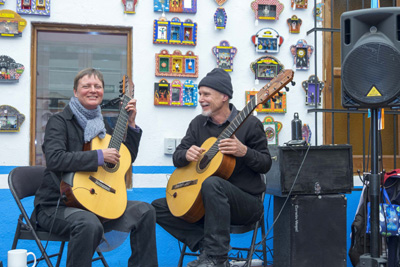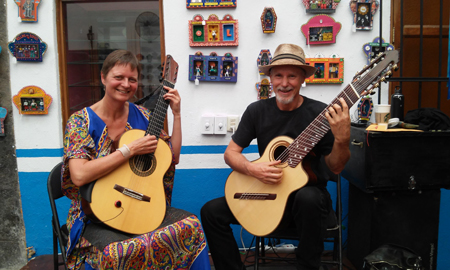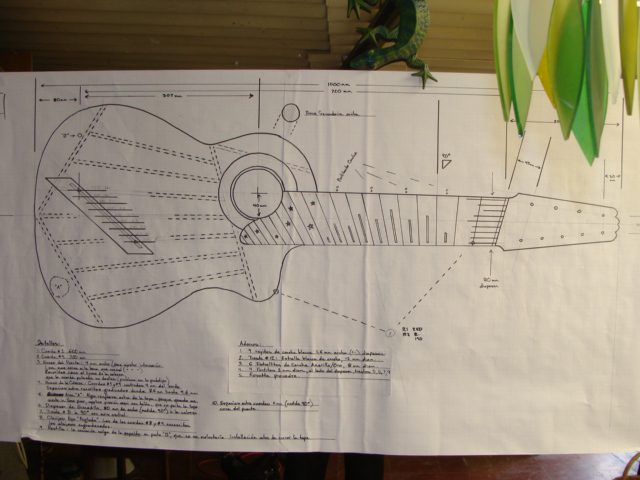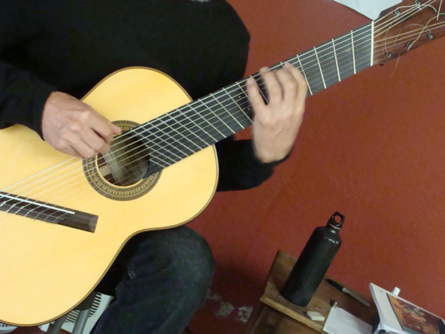Jack's 9-string Fanned Fret Harp Guitar Project:
A Five Octave Extended Range Classical Guitar:
Español (google traductor, disculpe)
Site Map
 These pages are about the design
and the construction of a nine-string extended range classical guitar
with fanned frets and a five-octave range, built in Paracho, Michoacan, Mexico,
by luthier Salvador Castillo
in February and March of 2016. The purpose of these pages is to
share information on the specifications, design process and design details with other guitarists or luthiers who may be interested in
such a design. Such information was very difficult to come by when we started this process. As matters stand, the guitar has proven to
be a tremendous success in all respects. Although it is admittedly a quirky and experimental instrument, and although there is always
room for more experimentation, this is a very playable design which others may wish to emulate. It is not for people with small hands,
or for the faint of heart.
These pages are about the design
and the construction of a nine-string extended range classical guitar
with fanned frets and a five-octave range, built in Paracho, Michoacan, Mexico,
by luthier Salvador Castillo
in February and March of 2016. The purpose of these pages is to
share information on the specifications, design process and design details with other guitarists or luthiers who may be interested in
such a design. Such information was very difficult to come by when we started this process. As matters stand, the guitar has proven to
be a tremendous success in all respects. Although it is admittedly a quirky and experimental instrument, and although there is always
room for more experimentation, this is a very playable design which others may wish to emulate. It is not for people with small hands,
or for the faint of heart.
This success was only achieved by first building a prototype (2013 - picture at right) which was not such a success, although a very interesting instrument. The proving of a design through successive prototypes is a very expensive process, and since we now know by experience that some of the apparently logical possibilities that appeared reasonable at the beginning of the design process proved to be mistakes, and since we perceive no financial advantage to ourselves in keeping this information secret or proprietary as others have done in the past, we would like to openly share the history of the project, and the conclusions reached, here. We sincerely hope that other guitarists and luthiers will take this design and continue to improve it.
 The guitar is a nine string fanned fret design, tuned as follows:
The guitar is a nine string fanned fret design, tuned as follows:F#1 B1 E2 A2 D3 G3 B3 E4 A4.
The first design was drawn in 2013, and the prototype was finished in September of that year. The revised design was commissioned from the same luthier, Salvador Castillo, in January 2016, and completed in March 2016.
We used the term "Harp Guitar" for poetic value only, during the fund-raising period when we needed a good sound byte. This design is quite different from the conventional 19th-century Italian Harp Guitar design, not only because of its fanned frets, but also because the fanned fret design allows the extra bass strings to be fully functional on the fingerboard, with a full range of chromatic pitches. Most harp guitars both historical and modern have mono-pitched bass strings, which although beautiful sounding are necessarily of extremely limited musical use. This improved design uses the fanned frets to achieve a completely seamless integration of all nine strings into a single workable system, without the use of many redundant mono-pitched basses, as are used in many extended range classical-style guitar designs such as the Yepes- or Marlow-style ten-string or the Swedish "Alto Guitar". It is most similar in design to the eight-string fanned fret "Brahms Guitar" design as played and popularized by Paul Galbraith. However, the incorporation of yet another bass register, down to F#1, demanded stretching the design of the fingerboard well past what has been done with any other fanned fret classical guitar designs to date, and also led to, in the revised 2016 design, the re-configuration of the entire internal bracing design, moving the sound-hole and using a lattice-braced top instead of the older and more traditional fan bracing.
The Design Process:
We used to say, as properly indoctrinated and handicapped residents of the Classical Guitar Ghetto, that the six-string guitar constituted an "elegant set of limitations" - just as the hobo said of his wooden leg, making a virtue of necessity. Eventually we began to perceive the six-string guitar as an unnecessary set of limitations and began to consider how it might be possible to improve it. The specific musical reason for this change of attitude was the gradual discovery that in making arrangments for two guitars, the narrow range makes it difficult to place a good bass line underneath a melody and still have room between them for the middle harmony parts without the accompaniment going above the melody, without the redundance of unnecessary unisons, and without the two guitars stepping on each other's parts in various ways. I have not addressed this musical issue in these pages.The Construction Process:
Fortunately we had a sympathetic and insightful luthier to work with in the person of Salvador Castillo. We have visited his shop many times over many years, and have seen many experiments come out of his shop as well as many very fine guitars. We bought two six-strings from him in 2007 on which we played about a thousand gigs over a five-year period. Salvador was willing to take on the extremely uncertain and speculative project of the 2013 Nine-String Prototype, and was able three years later to take the revised design to another level entirely, in fact to a level of excellence that could not have been banked on: we would have been happy if the 2016 build sounded as good as the 2013 Prototype, with the various necessary details corrected, but in fact the sound quality and playability are an order of magnitude better. There are still some weaknesses in the design that could be improved by the construction of the next guitar in the series, but we may never have another one built, because this one is a fully functional work instrument that has been proven for three years on the band stand, and to get another 5 or 10% improvement does not, at this time, seem worth the investment. Pictures and a description of the construction process may be found on the details page.The Fund Raiser:
The phase of the project which occupied most of January and February of 2016 was a four-part fund-raising endeavor involving:- Sale of a number of our older guitars.
- Sale of a compilation CD of Jack's original compositions.
- A lecture and concert at the Shelter Theater in San Miguel de Allende
- A request for donations (a number of close friends and fans helped with this project and we are very grateful.)
The Shelter Theater's weekly Open Mic
was the venue for many test flights of the 2013 Prototype 9-string
Fanned Fret Harp Guitar over several years,
as well as being the venue of our February 2016 fund-raising event for the 9-string project.
Special thanks are also due to the following friends, fans, and supporters:
Special thanks are also due to the following friends, fans, and supporters:
- Bryan Townsend
- Alonso Cardenas
- Helen Sims
- John Wharton
- David Johansen
- Ed and Herm
- Nolan
- Yves
- Chizuko
- Anne Marie
- Bob Block
- Adrian
- Sean
- Gerardo at ArtPrint
- and everyone who attended the Shelter Theater event on February 24th, 2016.
The 9-string Fanned Fret Harp Guitar
This design is the culmination of many years of thought, and is the logical extension of known design techniques to incorporate two additional, fully functional deep bass strings (tuned B1 and F#1) and one additional higher treble string (tuned A4) to the usual six strings of the guitar. The fanned fret design permits the effective combination of very thin, high-pitched strings - which require a short string length - with very thick, low-pitched strings - which require a long string length - on the same instrument, with all of the strings fully functional on the fret board. (Most competing designs lack complete functionality of the bass strings; that is, the strings added either lack frets, as in the typical 19th-century Italian-style 9-string Harp Guitar, or have unusual fretting arrangements which are either redundant, or which don't allow a complete chromatic bass range, as in the Swedish Alto Guitar.)The Prototype was finished in September 2013 (picture below right). The prototype revealed several design flaws, which was not an unexpected result in such an experimental design as this. After having the prototype built, more than two years of study and reflection were necessary before committing to a revised design. The errors in the prototype design were thoroughly analyzed and the resulting information incorporated in the new design, conceived in 2015 by Jack, who made many preliminary drawings, and reviewed and revised by Salvador Castillo, the luthier, who revised the technical details to accord with his own most successful recent guitar designs.
Why would anybody want such an unusual instrument? (See also the FAQs.)
The design is a modern update of the Baroque lute, taking advantage of modern string technology and design techniques, and combines in one instrument the ranges of the double bass, the guitar, the Renaissance lute, and the Mexican requinto (that's a small guitar tuned a fourth higher than normal.) It is the most compact, efficient, and playable design yet for such an extended range classical-type guitar. Although the range is not the maximum which has been attempted, this is a very successful instrument in achieving a playable 5 octaves.
The New 9-string Fanned Fret Harp Guitar, finished in late March, 2016, incorporates significant design improvements over the Prototype of 2013 (shown below). The drawing above is Jack's 2015 concept drawing and does not show a number of necessary design details which were filled in by Salvador Castillo.
The 2013 Prototype: (Engelman Spruce and Palo Escrito)
